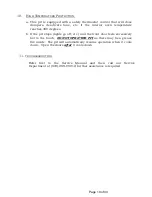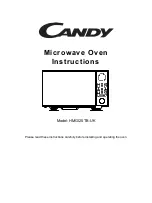
WARNINGS!
DANGER-Risk of Fire or Explosion
Do not burn garbage, gasoline, drain oil or other flammable liquids
Dedicated flue
If this unit is to be directly vented (no exhaust hood) do not connect to a flue serving
another appliance.
CAUTION-Hot Surfaces
Keep children away
.
Do not touch during operation
.
WARNING-Risk of Fire
Do
not operate with
flue draft exceeding 0.03 in. water column.
Do not operate
fuel loading or ash removal doors open.
Do not s
tore
fuel or other combustible material within marked installatio
n
clearan
ces.
Inspect and clean flues and chimney regularly
If the oven temperature reaches 450 degrees F, a high limit thermostat will
temporarily interrupt the temperature control function (it will
automatically resume
when it cools
down
)
.
If this occurs (or if the indicating thermostat shows an
abnormally high temperature) and the front doors feel excessively hot,
DO NOT
OPEN THE DOORS
,
as there may be a grease fire inside.
Open the doors only
after it cools down.
Contact your supervisor (if applicable) while continuing to
observe the pit. If you observe any flames, or perceive any fire threat,
immediately contact the local fire department.
Disposal of Ashes
Ashes should be placed in a metal container with a tight-fitting lid. J&R offers ash
carts suitable for this purpose. The closed container of ashes should be placed on
a noncombustible floor or on the ground, well away from all combustible materials,
pending final disposal. If the ashes are disposed of by burial in soil or otherwise
locally dispersed, they should be retained in the closed container until all cinders
have thoroughly cooled.
Creosote – Formation and Need for Removal –
When wood is burned slowly, it produces tar and other organic vapors, which
combine with expelled moisture to form creosote. The creosote vapors condense
in the relatively cool chimney flue of a slow-burning fire. As a result, creosote
residue accumulates on the flue lining. When ignited this creosote makes an
extremely hot fire. The chimney connector and chimney should be inspected at
least twice monthly
to determine if a creosote buildup has occurred. If creosote
has accumulated it
should be removed to reduce the risk of a chimney fire.
Summary of Contents for 250 FSE
Page 4: ......
Page 5: ......
Page 6: ......
Page 8: ......
Page 9: ...Page 1 of 47...
Page 13: ...Page 5 of 47...
Page 14: ...Page 6 of 47...
Page 15: ...Page 7 of 47...
Page 22: ...Page 14 of 47...
Page 23: ...Page 15 of 47...
Page 24: ...Page 16 of 47...
Page 25: ...Page 17 of 47...
Page 26: ...Page 18 of 47...
Page 27: ...Page 19 of 47...
Page 29: ...Page 21 of 47...
Page 30: ...Page 22 of 47...
Page 31: ...Page 23 of 47...
Page 32: ...Page 24 of 47...
Page 33: ...Page 25 of 47...
Page 34: ...Page 26 of 47...
Page 35: ...Page 27 of 47...
Page 36: ...Page 28 of 47...
Page 37: ...Page 29 of 47...
Page 38: ...Page 30 of 47...
Page 39: ...Page 31 of 47...
Page 40: ...Page 32 of 47...
Page 41: ...Page 33 of 47...
Page 42: ...Page 34 of 47...
Page 43: ...Page 35 of 47...
Page 44: ...lJD Page 36 of 47...
Page 45: ...Page 37 of 47...
Page 46: ...Page 38 of 47...
Page 51: ...Page 43 of 47...
Page 52: ...Page 44 of 47...
Page 56: ......




































